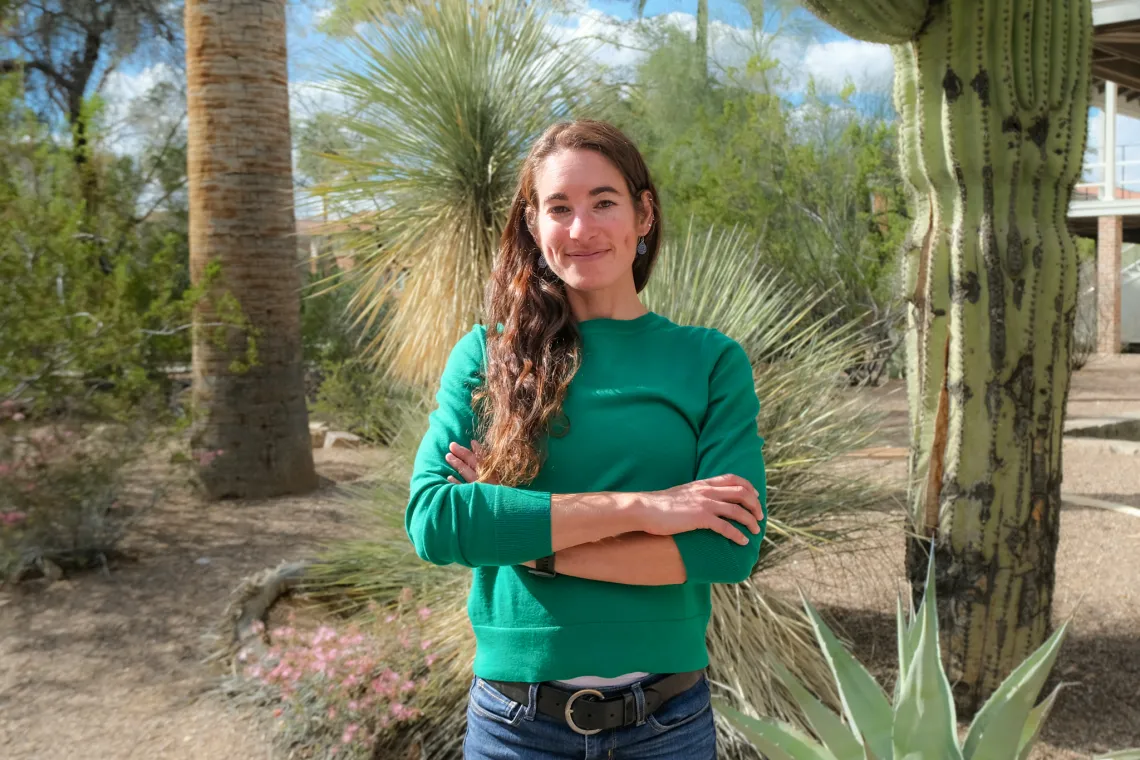Newest Environmental Science faculty brings fresh research perspective to land-atmosphere interactions
Dr. Julia Green joins the University of Arizona department from UC Berkley, and plans to collaborate with researchers to connect miniscule observations on land to large-scale events in the atmosphere

Imagine a pore on a plant leaf altering entire rainfall patterns in the area. Something so small having a direct effect on such a large-scale event may seem improbable, but this is exactly the type of research Dr. Julia Green focuses on.
Green joined the Environmental Science department at the University of Arizona in February as the newest faculty member, and is bringing a fresh perspective to land-atmosphere interactions by connecting miniscule observations to large scale data.
“There is a large disconnect between the people who work at the leaf level taking samples on the ground and those who are working with satellites looking at one degree by one degree latitude and longitude,” Green said. “So, I am really conscious of bridging both spatial scales to get a full understanding of what is actually happening.”
Green's latest research is focused on evaluating models representing the opening and closing of stomata, or pores, on plants related to changes in moisture availability.
When photosynthesis occurs, Green explained, these pores open and take in CO2, but simultaneously lose water which then evaporates into the atmosphere and contributes to rainfall and cloud formation.
“When you’re just looking at a single leaf, it’s one thing. But when you add this all up in a whole forest, the process has a much larger effect,” Green said.
To evaluate models for a process like this, multiple tools are needed at both spatial scales. Green said she will often use large-scale data, like thermal land surface temperature, and then compare directly to data collected with smaller-scale tools like flux towers and direct observations.
Although her experience is mostly in rainforest and large-scale global research, connecting both spatial scales can be extremely useful in all ecosystem research, including the semi-arid ecosystems of southern Arizona.
“One great example of bridging spatial scales in our department research could be collaborating with other faculty who are doing phytoremediation at mine sites,” Green said. “Especially at the large mine sites, my work could look at all the plants they are introducing and see if there is feedback in atmospheric patterns in a finer spatial scale.”
Collaboration is a key component in Green’s work, which she realized during a research trip to South America during her PhD.
Green studied civil and environmental engineering for her bachelor's and master’s degrees before working in environmental consulting. But after a few years of working, she decided to return to academia to pursue research again.
Early in her PhD program, she was doubting her decision to return to academia when her advisor invited her on a life-changing research trip to the Amazon Rainforest, where she worked side-by-side with multidisciplinary researchers from around the world.
“I basically went into that trip thinking I wanted to drop out,” Green said. “After hearing how passionate these scientists talk about their research, I came out of it saying, ‘This is awesome, when I’m 60 that is how I want to feel about my job.’”
Green received her PhD in environmental engineering from Columbia University and continued to her postdoctoral position at the Laboratoire des Sciences du Climat et de l’Environnement in France (LSCE) for two years and then to another postdoctoral position at UC Berkley before receiving her first faculty appointment at the University of Arizona.
Throughout her life and academic career, Green has traveled and met people from around the world, which she credits her PhD advisor, Dr. Pierre Gentine, for much of. She said as she begins advising and mentoring her own students, she will share many of the same ideas with them.
“Pierre did a great job of getting me involved with a lot of scientists and it really paid off, so I want my students to have that same opportunity,” Green said. “I also want them to spend some time in the field. When you work with environmental systems it’s easy to see everything as numbers, but when you take the time to go out in the field you remember what it all really means and that these are real, living plants.”
Green plans to seamlessly transfer her current research projects to the Environmental Science department and begin teaching related courses next year.
